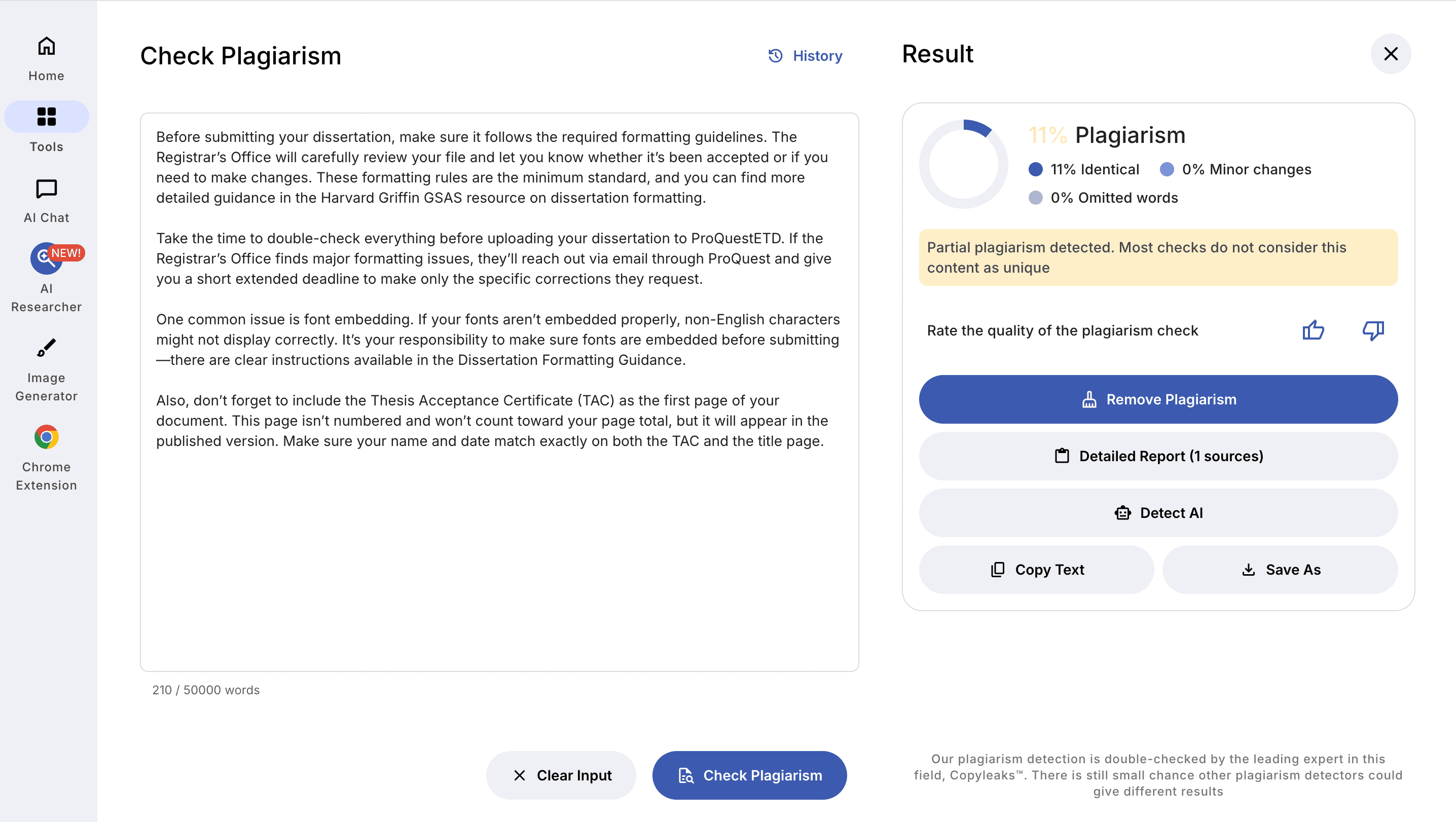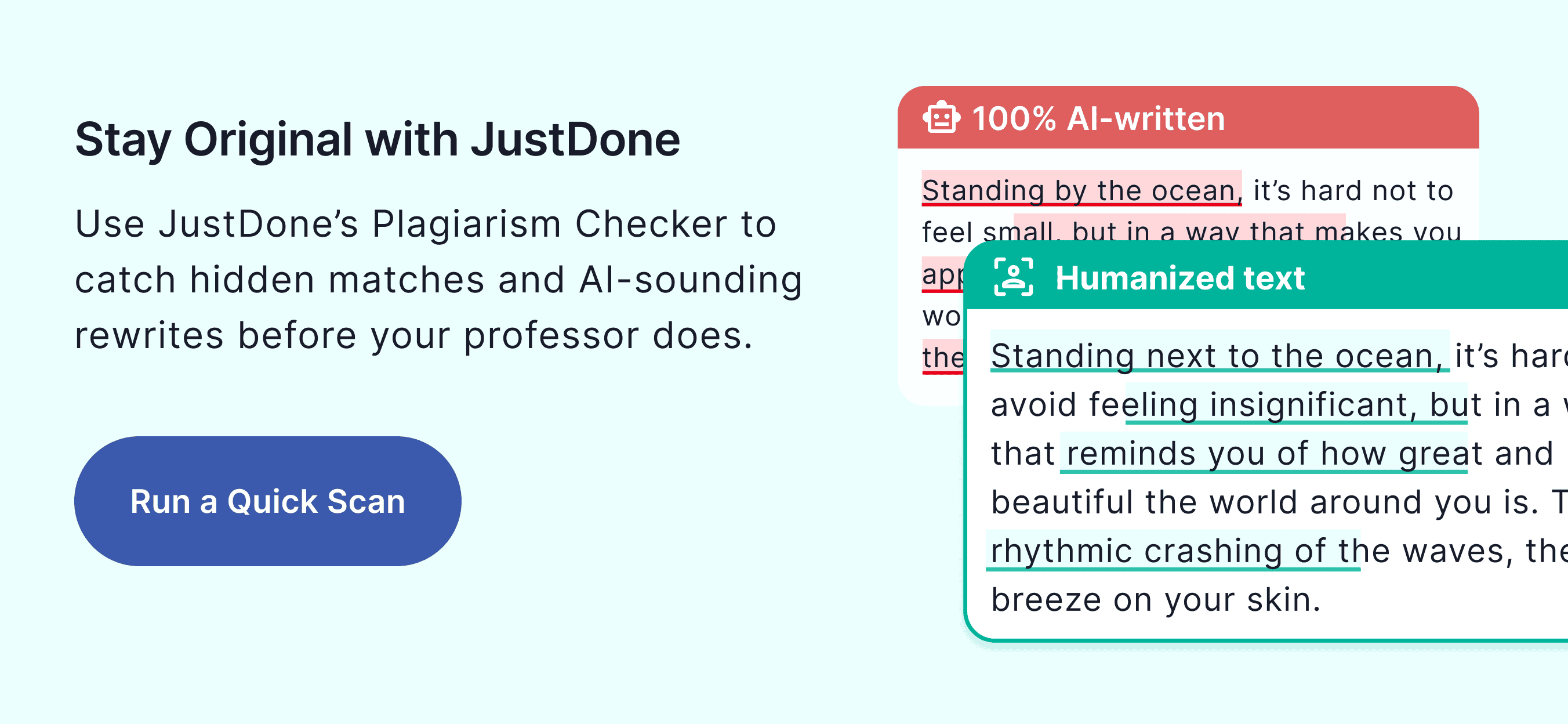Plagiarism is the word that alone can send a chill down your spine, especially if you're a learner who is working on a big assignment. You've double-checked your sources, paraphrased diligently, maybe even run your draft through a plagiarism checker. But the question still lingers: What percentage of plagiarism is acceptable? Or is any amount okay?
This is something I get asked a lot. And honestly, the answer isn’t as black and white as you'd think. So let’s walk through it clearly and practically.
What Percentage of Plagiarism Is Allowed?
Wondering what's an acceptable amount of plagiarism? The quick answer? Usually under 15%. But numbers can be misleading.
That 15% isn’t a hard rule, it’s a guideline. A checker might flag phrases that are perfectly fine, like citations or common definitions. So what matters more is what makes up that percentage.
For example, a JustDone plagiarism checker showing 11% could be perfectly acceptable if it consists mainly of properly cited sources and standard terminology.

If you’re seeing under 10%, you’re likely in the clear; most of what’s flagged is usually common language or cited sources.
Between 10 and 15%, you’ll want to double-check what’s being picked up. Above 15%, you’re entering a risk zone that may include too much quoted material or not enough original thought. And if it’s over 25%, there’s a good chance it’ll raise concerns, especially if sources aren’t properly credited.
Always ask your teacher what’s acceptable for their class. Some expect near-zero, others are more flexible.
In the workplace, standards can be even higher. When I helped an editorial team evaluate content submissions, even a 5% match could be an issue if it wasn’t properly attributed. So if you’re publishing online or preparing academic research, aim for as close to 0% as possible. And always give credit where it’s due.
Who Decides What Percentage of Plagiarism is Acceptable?
There’s no universal rule for what percentage of plagiarism is considered acceptable. It really depends on where you’re submitting your work. Different institutions set different rules. Most universities tend to use 15% as a general guideline, but what really matters is how that percentage breaks down. If your score comes mostly from properly quoted and cited material, it’s usually not a problem.
Academic journals and publishers tend to be a lot tougher. They often expect a plagiarism score well under 10%, especially for research that’s supposed to be completely original. High schools, on the other hand, vary quite a bit. Some may be fine with up to 20%, while others expect students to submit almost entirely original content.
Because the expectations aren’t the same everywhere, it’s best not to fixate on the number alone. Always double-check your school or organization’s policy, or ask your teacher directly. And if you’re not sure, it’s safest to aim lower—cleaner is always better when it comes to originality.
How to Read a Plagiarism Scan Report
Say you run your draft through plagiarism checker and see a 13% match. Don’t panic. Take a closer look.
That number alone doesn’t say much. Instead, check what the report actually highlights. Are those 13% flagged matches direct quotes you cited properly? Are they the assignment prompt or widely-used phrases? If so, you’re probably in good shape.
What you need to be cautious of is large blocks of text that closely mimic your sources but lack proper attribution. These are the real red flags and where most unintentional plagiarism happens.
Use the report as a guide, not a verdict. It helps you identify parts to improve, not punish you.

Why "Acceptable Percentage of Plagiarism" Isn’t the Whole Picture
Here’s something most people don’t tell you: a 12% plagiarism score can be worse than a 20% one.
Let me explain. If your 12% includes one full paragraph copied from Wikipedia with no citation, that’s a serious issue. But if your 20% includes 10 properly cited quotes? That’s often fine.
The takeaway? Always read your report. Don’t just glance at the number.
Working with students a lot, I often see a few scenarios that they mostly struggle with. These situations trigger plagiarism frequently. Some situations are trickier than they seem. For example, common knowledge like “Water boils at 100°C” may still show up as a match, but it’s not something you need to cite. You’re unlikely to be penalized for using widely known facts or definitions.
Rewriting content without truly changing the structure is another common trap. Students often think they’ve paraphrased well just by swapping out a few words. But if the original structure remains, it may still be flagged. The key is to really understand the material and then explain it in your own way.
And when you’re working with classmates on similar assignments, overlaps are common. Even if you didn’t copy each other, shared outlines or phrasing can trigger similarity matches. That’s why it’s smart to run your final work through a tool like JustDone before you turn it in.
Tips to Keep Your Plagiarism Score Low
How to reduce the plagiarism percentage in your work? Keeping your plagiarism score low doesn’t have to feel like a game of academic roulette. I’ve been through enough late-night paper scrambles to know it’s not always about copying on purpose. In contrast, it’s often just not knowing how to check yourself properly. Over time, I’ve picked up a few habits that keep things clean and make the whole process less stressful.
First off, always give credit where it’s due, even for ideas, not just direct quotes. If something came from a book, article, classmate, or even a blog post you read last week, it deserves a mention. Citing sources shows you’re doing the work honestly, and it adds weight to your writing.
When you’re paraphrasing, don’t just swap out a few words and call it a day. Really try to explain the idea in your own way, like you’re breaking it down for someone who’s never heard it before. For example, instead of writing, “Climate change leads to rising sea levels,” you could say, “As the planet heats up, melting ice from the poles causes sea levels to rise and flood low-lying areas.” It’s the same idea, but now it’s filtered through your own understanding.
Besides, if I check early, I’ve got time to fix anything that comes up: no last-minute panic, just one more part of the writing process. JustDone’s plagiarism checker and other tools are solid for this because they highlight not only copied parts but also things that sound too AI-ish.
I also make a habit of keeping all my drafts, especially for big assignments. That way, if there’s ever a question about where something came from or how I wrote it, I can go back and show how the writing evolved. It’s saved me more than once when a professor asked to see how I’d developed my argument.
And if you’re stuck or just unsure what counts as plagiarism, don’t guess. Ask your instructor; they’d rather you ask than get it wrong. Or use tools like JustDone to scan your draft for originality and clarity. I’ve found that even just seeing a few phrases flagged makes me rethink how I’m explaining things and it makes the final paper stronger.
Final Thoughts on Plagiarism Percentage
If you take one thing away from this: It’s not about hitting 0%, it’s about writing honestly and revising smart. Plagiarism detection is a guide, not a verdict. A 12% score might be perfect or it might be a problem. The details matter.
Run your work through a solid plagiarism checker, read the report closely, and revise where needed. And when in doubt? Rewrite more than you think you have to.
It’s not about gaming the system. It’s about writing with confidence, knowing your ideas are your own, or clearly showing where they came from.